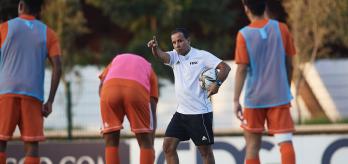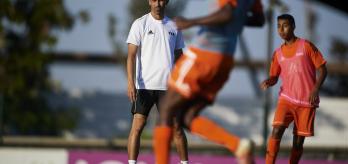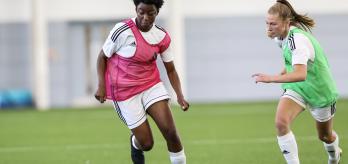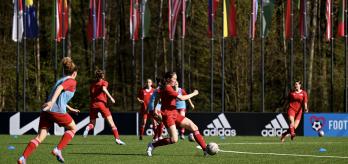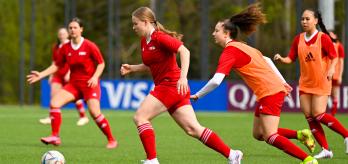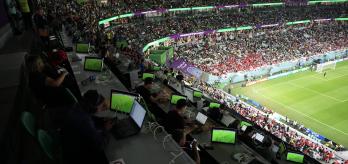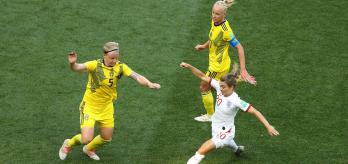To execute successful counter-pressing, a team must first get into the mindset and the habit of reacting quickly after losing possession. It is then essential to perform counter-pressing at high intensity and to work collectively in a coordinated manner; strong communication between the players is essential to achieve the latter.
In this session, Morocco U-13 coach Noureddine Boubou takes a group of 14 players, including two goalkeepers, through a series of exercises that instil a proactive attitude to losing the ball and develop the technical skills required to execute an effective counter-press.
The session is split into four parts, beginning with a warm-up made up of rondos. It then moves onto two different possession games focusing on transitions. To finish, the group participates in a large game in which Boubou coaches the attacking team.
Session overview
Key coaching points
- Players should react quickly to any loss of possession, with the player closest to the ball applying immediate pressure on the ball carrier to try and regain possession or at least to stop the opposition from playing forward.
- The team must quickly transition into a defensive shape to close down all space around the ball and create an overload to increase the chance of winning the ball back.
- The first defensive priority is to protect the centre of the pitch as soon as possession is lost in order to prevent or slow down the opponent's progression up the pitch.
- Communication is a key factor in any successful counter-pressing phase. Players must give clear information and instructions to the team-mates directly in front of them, helping them to make good decisions and take up effective positions.
This session was created with a set of specific, real-game scenarios in mind and aims to answer the following questions: how can a team counter-press effectively? And how can they then take advantage of the opponent's disorganisation in the few seconds just after they have regained possession?
Warm-up: Rondos
This session begins with a warm-up consisting of transitional rondo games. As well as preparing the players physically, these games introduce the topic of the session and allow Boubou to get the players into the mindset of reacting quickly to transitions.
-
Mark out four 8x8m boxes spaced out 10 metres from each other.
-
Place 4 players inside two of the boxes and 3 players in the other two.
-
Two 3v1 rondos take place inside two of the boxes.
-
Inside the other two boxes, 3 players pass the ball around while waiting.
-
As soon as a player loses the ball in one of the two rondos, they must run into another box and try to win the ball.
-
Variation I:
-
-
Mark out three 10x10m boxes spaced out 10 metres from each other.
-
Place 4 players inside two of the boxes and 6 players in the remaining box.
-
A 4v2 rondo takes place in the box with 6 players, while the players in the other two boxes pass the ball around while waiting.
-
As soon as a player loses the ball in the rondo, they and the team-mate to their left must run into another box and try to win the ball.
-
Players are limited to 2 touches.
-
-
Variation II:
-
-
When one of the two defenders wins the ball, they must pass the ball into another box.
-
The group of 4 who just lost the ball can try to win it back before the defenders have time to play out.
-
-
Prepare the players to react to defensive transitions to try to regain possession as quickly as possible.
-
Players meed to show a quick and coordinated reaction to losing possession and should press as a unit.
Part 1: 4v4+4 – possession game
The session continues with a three-team possession game in which one team try to keep possession against another, while using the support of four neutral players. To encourage players to react quickly to defensive transitions, teams change roles as soon as there is a turnover of possession. The team who lose the ball therefore need to press immediately, trying to regain possession as quickly as possible.
-
Mark out an 18x12m pitch, using 2 cones to mark the halfway line.
-
Position two teams of 4 and 2 neutral players inside the playing area.
-
Place 1 neutral player outside each end of the playing area.
-
Place 4 mini-goals outside the playing area, about 5 metres away from each corner.
-
One team of 4 aim to keep possession against the other team.
-
The 4 neutral players play with the team in possession.
-
As soon as the defending team win the ball, both teams switch roles.
-
The team in possession are limited to three touches.
-
The neutral players are limited to two touches.
-
The team in possession are limited to two touches and the neutral players to one touch.
-
After regaining possession, the defending team must try to score in one of the four mini-goals.
-
When possession is lost, the player closest to the ball must press immediately to put the opponent under pressure and try to regain possession as quickly as possible, or at least prevent the opposition from playing forward.
-
It is essential that players communicate within their team when pressing and trying to regain possession to coordinate their movements.
-
When defending, the priority of the team should be to protect the centre of the pitch. Players should maintain a compact shape to block penetrative passes through central areas and force the opponent to play out wide, where it will be easier to regain possession.
Part 2: 7+1v6 – possession game
The session progresses into a three-zone possession game involving attacking and defensive transitions. As well as building upon previous exercises to develop the players' ability to react quickly to transitions, this practice helps them to understand the benefits of overloading the opponent and taking up effective positioning in possession in order to prepare for a potential turnover.
-
Mark out a 30x20m area.
-
Use 4 cones to mark out a 5m-wide central channel (which will also create a wide area to the left and right of it).
-
Place 2 mini-goals 8 metres away from the wide areas.
-
Split the players into a blue team of 7, an orange team of 6, and a support player.
-
5 blue players, 3 orange players and the support player are positioned in one of the wide areas.
-
A blue player and an orange player are positioned in the central channel.
-
A blue player and 2 orange players are positioned in the other wide area.
-
The game starts in one of the wide areas with a 5+1v3 possession phase.
-
If the 3 orange players win the ball, they try to switch the play to their two team-mates in the other wide area.
-
If they lose possession, the 5 blue players try to regain it as quickly as possible.
-
If they regain possession, they can start an attack on the large goal by playing behind the playing area, with players from all 3 zones allowed to attack.
-
The orange players are not allowed to defend outside of the playing area.
-
The team in possession are limited to 3 touches.
-
Change the disposition within the boxes: 4 blue players, 3 orange players and the support player are positioned in one of the wide areas.
-
The defending team can try to score in either of the mini-goals after winning the ball.
-
The team in possession are limited to 2 touches .
-
The defending team are allowed to defend outside the playing area.
-
The team in possession must try to win the ball back within 5 seconds if they lose it.
-
When a team regain possession, they must look to play forward as soon as possible to take advantage of the opponent's disorganisation.
-
As soon as they lose the ball, the team should react as quickly as possible to counter-press in a collective effort. The player closest to the ball must press the ball carrier to put them under pressure. Meanwhile, their team-mates must cover the space created behind the pressing player, protecting the vital central areas of the pitch.
-
As a team, the players should look to overload the area in which possession was lost to increase the chance of regaining possession and to prevent the opponent from escaping the area.
-
Communication among the players is key to successfully recovering possession.
-
The team in possession should look to stretch the pitch as much as possible so that they can force the opposition to shift and reposition accordingly, which can lead to gaps being created to move the ball forward.
-
The goalkeepers should also be ready for a quick transition into attack, should an opportunity present itself.
Part 3: 11v10
To finish off the session, the players take part in a 11v10 game, giving them the opportunity to apply what they have learnt throughout the session in a match situation.
-
Use ⅔ of the length of a pitch and narrow its width by 7 metres on each side.
-
Place two 11-a-side goals at each end of the playing area.
-
Mark out a halfway line with 2 cones.
-
Split the players into a blue team of 11 and an orange team of 10.
-
The blue team attack and are set up in a 4-3-3 formation.
-
The orange team defend and are set up in a 4-3-2 formation, defending in a medium to low block.
-
Place the spare balls in the blue team's goal.
-
Play starts with the blue team's goalkeeper.
-
The orange team must try to complete 5 consecutive passes after regaining possession in order to win a point.
-
The blue team must try to regain possession within 5 seconds of losing the ball.
-
As soon as the ball is lost, the team must transition as quickly as possible into its defensive shape to reduce the space and get compact around the ball.
-
The ball carrier must be closed down immediately to prevent them from playing forward or escaping from the area in which the ball was recovered. The player pressing the ball must be able to isolate the ball carrier by pressing them from the correct angle, allowing them to screen a potential forward pass and force the opponent into playing in a specific direction.
-
The players around the ball should get into central positions and overload the centre of the pitch to increase their chances of regaining possession.
-
The counter-press must be performed at high intensity to put the opponent under pressure and to increase the chances of a turnover.





